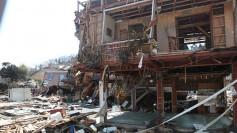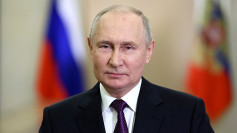A powerful 7.0 magnitude earthquake struck off the eastern coast of Russia's Kamchatka Peninsula early Sunday, triggering an eruption from one of the region's most active volcanoes, Shiveluch. The seismic event has raised alarms among scientists, who warn that an even stronger earthquake could be imminent.
The Shiveluch volcano, situated on the remote Kamchatka Peninsula, began spewing plumes of ash reaching 5 kilometers (3 miles) into the sky shortly after the earthquake, according to volcanologists from the Russian Academy of Sciences. The eruption prompted a brief "code red" warning for aircraft, signaling the potential danger posed by the ash cloud to aviation in the area.
Video footage released by the Academy's Institute of Volcanology and Seismology shows the vast ash cloud stretching over 490 kilometers (304 miles) to the east and southeast of the volcano. The Kamchatka Volcanic Eruption Response Team confirmed that the "code red" warning had been issued, but the alert was later downgraded as no commercial flights were disrupted, and there was no reported damage to aviation infrastructure.
The earthquake, which struck at a depth of 18 kilometers (11 miles) beneath the sea bed, had its epicenter 108 kilometers (67 miles) southeast of Petropavlovsk-Kamchatsky, a coastal city home to over 180,000 residents. This city, which also serves as a key Russian submarine base, experienced some of the strongest tremors felt in the region in recent years, according to local reports.
Residents of Petropavlovsk-Kamchatsky described the shaking as intense and unsettling, with some comparing it to the powerful 9.0 magnitude earthquake that struck Kamchatka in November 1952. That historic quake generated massive tsunami waves as high as 9.1 meters (30 feet) that reached as far as Hawaii, though it resulted in no reported deaths in Kamchatka itself.
The recent earthquake's effects were not limited to the Shiveluch volcano. The Ebeko volcano, located on the Kuril Islands to the south, also erupted, sending ash clouds 2.5 kilometers (1.5 miles) into the air. While it remains unclear whether the earthquake directly triggered these volcanic activities, the timing has heightened concerns about the region's geological stability.
Russian scientists have cautioned that Sunday's earthquake may be a precursor to an even more significant seismic event. The Institute of Volcanology warned that a second earthquake, potentially approaching a magnitude of 9.0, could strike the southeastern Kamchatka region within the next 24 hours. Such an event would have devastating implications, given the region's history of severe seismic activity.
Despite the intense seismic and volcanic activity, there have been no immediate reports of injuries or significant damage. The U.S. Geological Survey and the U.S. National Weather Service's Pacific Tsunami Warning Center in Honolulu initially issued a tsunami warning following the earthquake, but the threat was later lifted, calming fears of a broader catastrophe.
The Kamchatka Peninsula is one of the most seismically active regions in the world, sitting on the Pacific Ring of Fire, where tectonic plates frequently collide, causing earthquakes and volcanic eruptions. Shiveluch, one of Kamchatka's largest and most active volcanoes, has a long history of eruptions, and its current activity is being closely monitored by Russian and international scientists.
The dual threats of powerful earthquakes and volcanic eruptions pose ongoing challenges for the residents of Kamchatka, a region known for its rugged beauty and harsh natural environment. As scientists continue to monitor the situation, the potential for further seismic activity remains a significant concern.
The Russian Academy of Sciences and local authorities are urging residents to stay alert and prepared for any further developments. In the meantime, the eruption of Shiveluch serves as a stark reminder of the volatile and unpredictable nature of the forces shaping this remote corner of the world.






